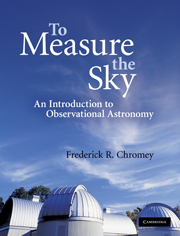3 - Place, time, and motion
Published online by Cambridge University Press: 05 June 2012
Summary
Then, just for a minute… he turned off the lights…. And then while we all still waited I understood that the terror of my dream was not about losing just vision, but the whole of myself, whatever that was. What you lose in blindness is the space around you, the place where you are, and without that you might not exist. You could be nowhere at all.
– Barbara Kingsolver, Animal Dreams, 1990Where is Mars? The center of our Galaxy? The brightest X-ray source? Where, indeed, are we? Astronomers have always needed to locate objects and events in space. As our science evolves, it demands ever more exact locations. Suppose, for example, an astronomer observes with an X-ray telescope and discovers a source that flashes on and off with a curious rhythm. Is this source a planet, a star, or the core of a galaxy? It is possible that the X-ray source will appear to be quite unremarkable at other wavelengths. The exact position for the X-ray source might be the only way to identify its optical or radio counterpart. Astronomers need to know where things are.
Likewise, knowing when something happens is often as important as where it happens. The rhythms of the spinning and orbiting Earth gave astronomy an early and intimate connection to timekeeping. Because our Universe is always changing, astronomers need to know what time it is.
- Type
- Chapter
- Information
- To Measure the SkyAn Introduction to Observational Astronomy, pp. 60 - 97Publisher: Cambridge University PressPrint publication year: 2010

